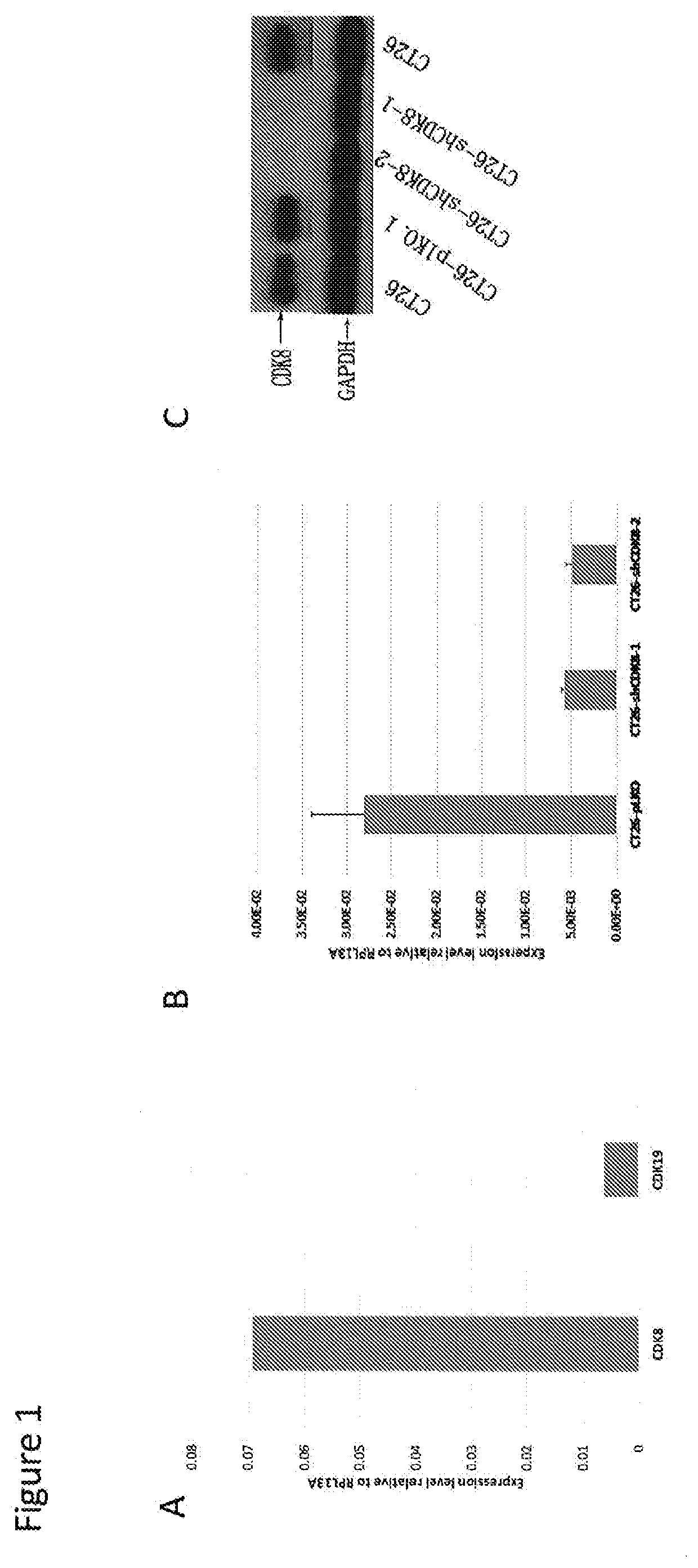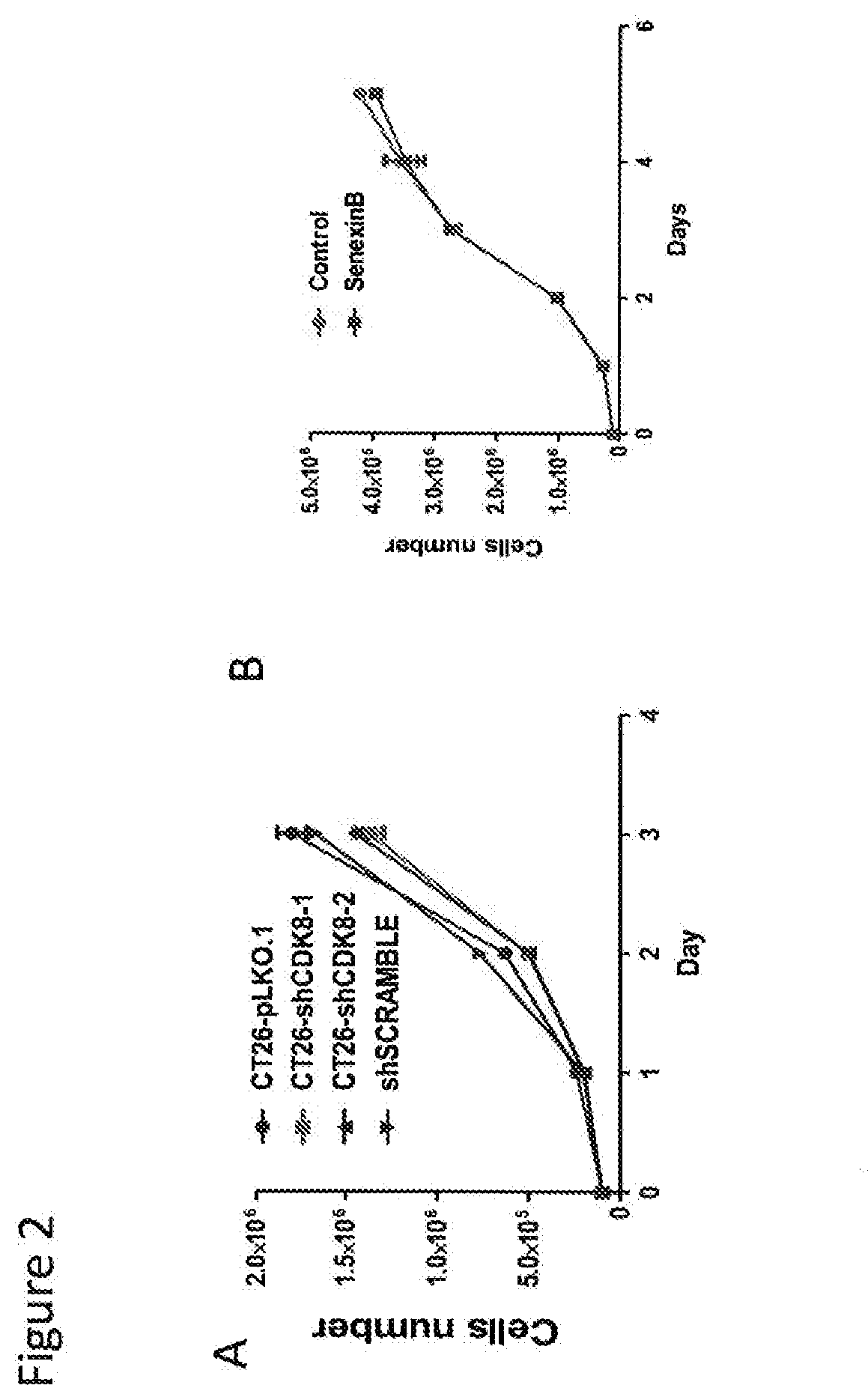Use of cdk8/19 inhibitors for treatment of established colon cancer hepatic metastasis
a technology of colon cancer and inhibitors, applied in the field of cancer treatment, can solve the problems of inability to detect significant growth inhibition of colon cancer cells, and achieve the effects of suppressing the growth of colon cancer hepatic metastases, safe use, and suppressing the growth of primary colon cancer xenografts
- Summary
- Abstract
- Description
- Claims
- Application Information
AI Technical Summary
Benefits of technology
Problems solved by technology
Method used
Image
Examples
example 1
with CDKS / 19 Inhibitor or shRNA Knockdown of CDKS in CT26 Colon Cancer Cells Suppresses Metastatic Growth in the Liver
[0024]To investigate the role of CDK8 / 19 in colon cancer growth and metastasis, we used murine CT26 colon cancer cell line, derived from a BALB / c mouse following chemical carcinogenesis (Griswold and Corbett, 1975). Cells were propagated in RPMI1640 medium with 10% Fetal Bovine Serum. FIG. 1A shows the results of quantitative reverse-transcription PCR (QPCR) assays for CDK8 and CDK19 in CT26 cells, carried out as described (McDermott et al., 2017) using the following pairs of PCR primers: CGGGTCGAGGACCTGTTTG (SEQ ID NO:1) and TGCCGACATAGAAATTCCAGTTC (SEQ ID NO:2) for CDK8 and GGTCAAGCCTGACAGCAAAGT (SEQ ID NO:3) and
[0025]TTCCTGGAAGTAAGGGTCCTG (SEQ ID NO:4) for CDK19. The results in FIG. 1A demonstrate that the expression of CDK19 in CT26 cells is very low relative to CDK8, and therefore only CDK8-targeting shRNAs needed to be used for stable knockdown of CDK8 / 19 in th...
example 2
Treatment Suppresses the Growth of Already-Established Liver Metastases
[0030]To determine if the anti-metastatic effects of CDK8 / 19 inhibition observed in the splenic injection model were due to the prevention of the initial establishment of hepatic metastases or growth inhibition of already-established metastases, we asked whether Senexin B can inhibit metastatic growth in the liver when the drug is administered after the metastases have been established. In agreement with previous characterization of the time course of hepatic metastasis following splenic injection of CT26 cells (Vidal-Vanaclocha, 2008), we found macroscopically and microscopically detectable metastatic tumors in the livers of mice sacrificed 7 days after splenic inoculation (FIG. 6A), indicating that the effect of a drug administered at a later point would have to involve suppression of metastatic growth. We compared the effects of Senexin B dimaleate on hepatic metastasis, when the drug was administered by gavag...
example 3
nhibition Extends the Survival of Colon Cancer Liver Metastasis
[0031]We have analyzed the survival of mice after splenic injection of 2×105 CT26 cells into 8 week old female BALB / c mice, followed by removal of the spleen 1 minute after injection. Mice were sacrificed when paralysis, lack of movement or paleness (due to abdominal hemorrhage) occurred. The sacrificed mice showed extensive liver metastasis (FIG. 7A). Kaplan-Meyer (KM) survival plots in FIG. 7B shows that mice injected with shCDK8-1 cells showed significantly extended survival relative to mice inoculated with vector control cells. On the other hand, Senexin B dimaleate treatment by gavage at 50 mg / kg in CD vehicle, b.i.d. prolonged the survival of mice inoculated with vector control cells to a similar degree as the survival time of mice inoculated with shCDK8-1 cells (FIG. 7B). The combination of knockdown of CDK8 and treatment with Senexin B together increased the survival time even further (FIG. 7B). To establish seru...
PUM
| Property | Measurement | Unit |
|---|---|---|
| weight | aaaaa | aaaaa |
| size | aaaaa | aaaaa |
| weights | aaaaa | aaaaa |
Abstract
Description
Claims
Application Information
 Login to View More
Login to View More - R&D
- Intellectual Property
- Life Sciences
- Materials
- Tech Scout
- Unparalleled Data Quality
- Higher Quality Content
- 60% Fewer Hallucinations
Browse by: Latest US Patents, China's latest patents, Technical Efficacy Thesaurus, Application Domain, Technology Topic, Popular Technical Reports.
© 2025 PatSnap. All rights reserved.Legal|Privacy policy|Modern Slavery Act Transparency Statement|Sitemap|About US| Contact US: help@patsnap.com



